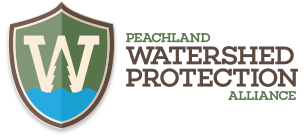Last fall the Trepanier neighbourhood was officially connected to the new water treatment plant (WTP), meaning all of Peachland now gets its water from Peachland Lake. The watershed watch crew did a trip up to the lake which is also now officially the reservoir for all of Peachland\’s drinking water.
We were pretty shocked by what we saw. How do these photos make you feel about our water source?
Where was all the water? Local back country experts have never seen it so low, while others said it was normal and that the freshet has no yet started. However, regular back-country users report that there is only patchy snow left in the upper elevations of the watershed that drains into Peachland lake. The Okanagan Basin Waterboard reports on “Mission Creek and Silver Star snow pillows appear to have recovered to normal levels for this time of year. However, Brenda Mines snow pillow is showing a rapid melt, much faster than normal. Okanagan Lake levels have now recovered, and are well within the normal range for this time of year.”
The Brenda Mines snow pillow is significantly lower and has been trending that way since February.
Are these water levels cause for concern?
We made inquiries to the District of Peachland but had not heard anything back by our deadline. Follow us on social media or visit our web page to get updates on what is really happening to our water reservoir.
What was clearly concerning is the mudbogging on the newly exposed lake bottom – this is horrible for our water, and for the water treatment plant and one of the reasons that the District had to install new equipment mere months after the WTP came online.
The unpredictable turbidity is a problem for water treatment plants. Despite signage (below) imploring people to ride above the high water mark, this idiot though it would be cool to do the exact opposite! If you\’re in the back-country/watershed please report destructive behaviour – if you are mad your taxes keep going up, these activities are one reason why.
The photo of the mud bogging in the gallery below, was taken from this exact location (usually underwater as you can see). It\’s clearly not above the high water mark!
Watershed Watch will make another field trip at the end of June and update you then.













